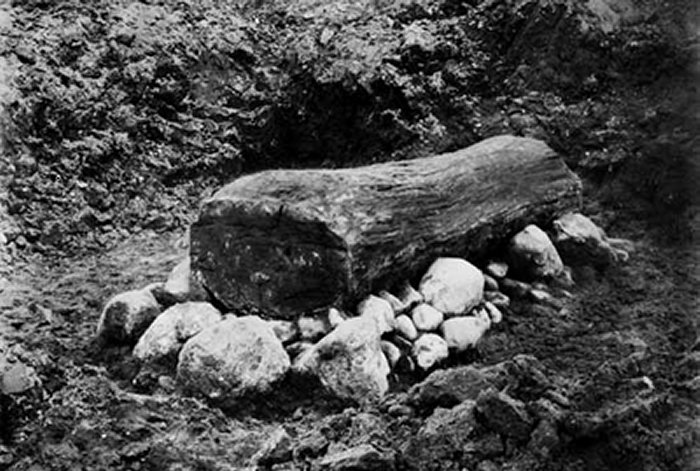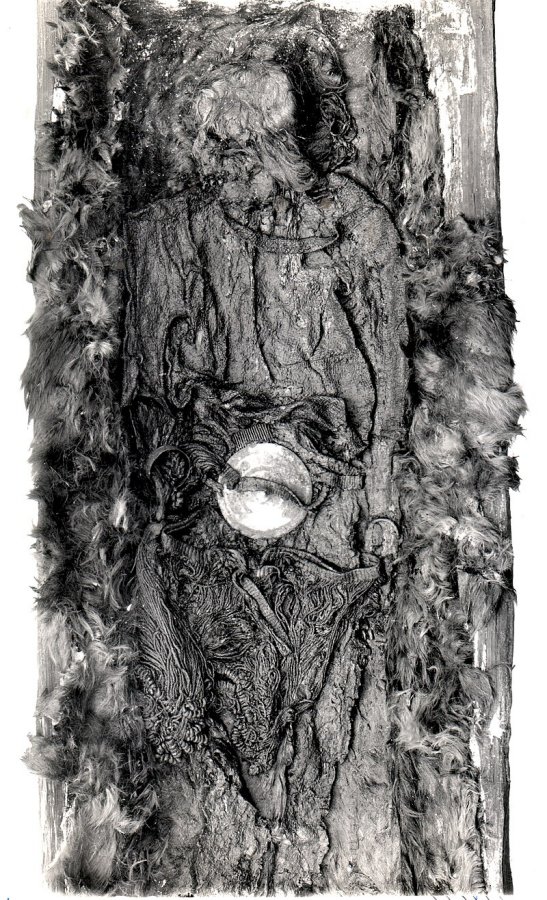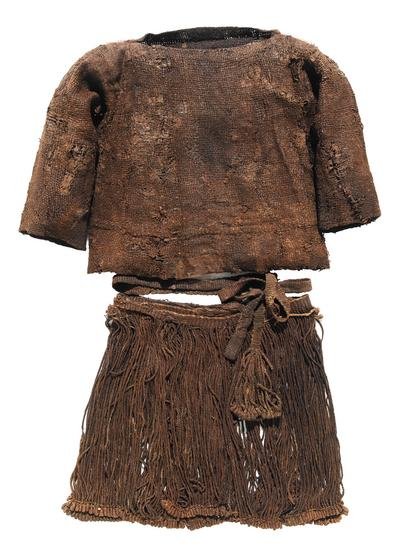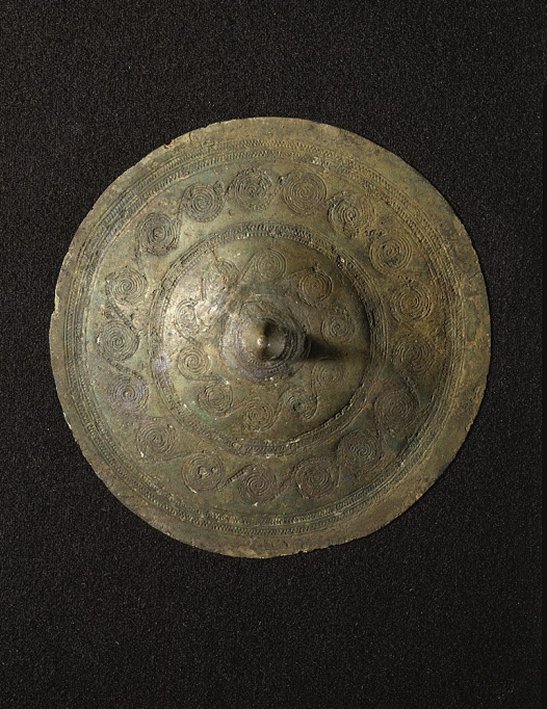Egtved Girl’s Unique 3,400-Year-Old Style Of Dress
Ellen Lloyd - AncientPages.com - About 3,400 years ago, a teenage girl died and was buried near Egtved, west of Vejle, Denmark. Although she is long gone, learning some things about her life is still possible. Her oak coffin was found in 1921 by Jutlandic farmer Peter Platzand and she was named the Egtved Girl. She had been covered with a wool blanket and put to rest in a hollowed-out, stripped oak trunk. One half functioned as a coffin and the other as its lid." 1
The Egtved Girl's coffin as it was excavated from the mound in 1921. The coffin was brought to the National Museum, where it was excavated and the contents were conserved. Credit: Natmus
After all this time, there was not much left of the Egtved Girl's skin or body in general, but her hair had been preserved, allowing experts to determine its color. Inside the coffin were also several grave goods and a yarrow flower had been placed on the edge of the coffin before the lid was put on, suggesting the girl had died in the summer.
"At the girl’s feet were the cremated remains of a 5-6-year-old child, who had probably died some time earlier.
The child shares strontium isotope values with the girl and whilst nothing suggests that they have traveled together, they seem to have come from the same place.
Their relationship to each other is unknown since neither of them left any DNA for analysis." 2
Where Did The Egtved Girl Come From?
Today, The Egtved Girl is regarded as one of Denmark's best-preserved Bronze Age finds. When scientists started to study her, they made a surprising find. Analysis of her teeth revealed the girl was not from Denmark. She was a migrant who had been traveling huge distances in the last 23 months of her life. This conclusion was based on analyzing her clothes, hair, and nails.
The mound Storehøj at Egtved, in which the young girl was buried in the summer of 1370 B.C. Credit: Natmus
"It's as wild as it can be. We’ve never had an indication that she shouldn’t be from the local area around Egtved, and when I started to investigate her clothes, it was to examine the contemporary trade patterns. We’re all extremely surprised," says PhD Karin Margarita Frei, who is a senior researcher at the National Museum.
"In peoples’ minds, the iconic Egtved girl is Danish. Now it turns out that in reality, she was a migrant.
That the girl was a traveller, and almost what we would today call a commuter, will surely have an impact on the direction of future research in the coming years,” says Professor Helle Vandkilde, who was not involved in the new study herself.
It is possible to learn much about a person by extracting DNA from the individual's hair, but this was not possible in the case of the Egtved Girl as "as all traces of DNA had been destroyed over time (due to the acidic environment in which she was buried." 2
However, clues to her origin came from the analysis of her nails, confirming that Denmark’s famous Bronze Age girl had traveled a lot.
"The strontium isotope analyses show that she made a least two long-distance journeys in the latter part of her life, between southern Germany and a place in South Jutland (Denmark) or northern Germany." 2
It is also likely that the girl was actually born in Southern Germany, and the Black Forest was most likely her home.
Remains of Egtved Girl with remains of clothing, and fur blanket. Credit: The Danish National Museum
This is significant information that puts historical events into perspective. Professor Kristian Kristiansen, who participated in the study of the Egtved Girl pointed out that "aAlthough it is incredible that anyone had travelled so far in the Bronze Age, it is even more incredible because she is a woman."
The Egtved Girl's grave. Photo credit: National Museum of Denmark and University of Copenhagen
"It's always the men we’ve spoken most about so it is important that we now have a woman in the picture. So far we’ve been able to show that merchants and warriors have moved, perhaps, 200 kilometres at the time. Yet until now, we have not had archaeological evidence that women have also moved this far.
Egtved girl's outfit in the grave. Credit: Natmus
The fact that we can prove that a woman made this journey, confirms to me that there was organised travel and trade between southern Germany and Denmark, and that they were connected with political alliances far beyond what we imagine," Professor Kristiansen explained.
The Egtved Girl’s Beer
Inside the girl's coffin, researchers found a bark bucket. "At the bottom lay a thick brown deposit. When the contents of the bucket were analyzed it became clear that it had contained a fermented drink – probably beer sweetened with honey. The drink was made from cowberries or cranberries. Wheat grains, remains of bog myrtle, and large quantities of pollen (including lime pollen) were also found.
Pollen is the "fingerprint" of plants and with the aid of careful analysis, it is possible to identify the plants that the drink contained." 1
The discovery led eventually to Denmark’s Skands Brewery, in co-operation with Denmark's National Museum launching the production of a wheat beer called Egtved Girl’s Brew based on the 3,400-year-old recipe found in the oak coffin.
The Egtved Girl’s Unique Dress
The story of the Egtved Girl becomes even more intriguing when we learn about her striking outfit that experts have reconstructed. Seeing how ancient people were dressed always brings the past closer to us. Reconstruction of prehistoric clothes, jewelry, houses, and anything that concerns daily life offers a unique glimpse into the past we will never experience in any other way than by studying images and reading books.
Belt plate of Egtved girl. Credit: Natmus
Based on the findings inside the Egtved Girl's coffin, scientists could conclude she had been wearing a spectacular cord skirt. "It went down to her knees, was wound twice around her waist, and was 38 cm long. This kind of skirt was in use throughout the Bronze Age.
"The costume was made up of several components: a blouse on the upper body, a sash with a belt-plate attached, a corded skirt, as well as pieces of textile around the feet and leather shoes.
The grave also contained a comb and two arm rings, one earring, an awl, some smaller pieces of textile made of wool." 3
"One could speculate that the corded skirt may have been made for her in her area of origin and it could be a piece of costume that was intended for her to grow into with age, or just to show her network." 3
The picture depicts a reconstruction of the clothing found in the coffin of the Egtved Girl.Photo: Lejre
"Some small female figures of bronze from Grevensvænge, Zealand, are also dressed in cord skirts. It has been suggested that the figures represent rituals that were performed at the cultic feasts of the Bronze Age. The women who were dressed in cord skirts may have performed ritual dances. Perhaps the Egtved Girl also took part in dancing rituals." 1
Her clothes were reconstructed for the National Museum of Denmark by the Lejre Experimental Centre. A reconstruction of her unique 3,400-year-old dress and details of the excavation can be seen at the National Museum of Denmark.
Written by Ellen Lloyd – AncientPages.com
Copyright © AncientPages.com All rights reserved. This material may not be published, broadcast, rewritten or redistributed in whole or part without the express written permission of AncientPages.com
Expand for references- The National Museum Of Denmark - The Egtved Girl’s Grave
- Charlotte Price Persson - A famous Danish Bronze Age icon turns out not to be Danish after all - Science Nordic
- Bergebrant, Sophie (2019). "Revisiting the Egtved Girl", Gothenburg University library website. NTNU Vitenskapsmuseet, Institutt for arkeologi og kulturhistorie og Museumsforlaget
More From Ancient Pages
-
 Norse God Tyr Who Gave Viking Warriors Courage And Self-Confidence In Battle
Featured Stories | Mar 7, 2018
Norse God Tyr Who Gave Viking Warriors Courage And Self-Confidence In Battle
Featured Stories | Mar 7, 2018 -
 Saqqara New Discoveries: Fifth Dynasty’s Pyramid Complex That Belonged To Queen Setibhor
Archaeology | Apr 15, 2019
Saqqara New Discoveries: Fifth Dynasty’s Pyramid Complex That Belonged To Queen Setibhor
Archaeology | Apr 15, 2019 -
 Surprising Time Capsule In Antarctica – Evidence Of Toxic Heavy Metal Pollution 800 Years Ago
Earth Changes | Jan 18, 2024
Surprising Time Capsule In Antarctica – Evidence Of Toxic Heavy Metal Pollution 800 Years Ago
Earth Changes | Jan 18, 2024 -
 Enigma Of Mount Ararat – Researchers Are Determined To Reveal The Truth To The World
Featured Stories | Jun 27, 2014
Enigma Of Mount Ararat – Researchers Are Determined To Reveal The Truth To The World
Featured Stories | Jun 27, 2014 -
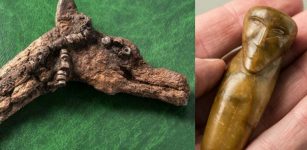 Ancient Doll And Mythical Animal – 4,500-Year-Old Toys Discovered In Siberia
Archaeology | Dec 30, 2017
Ancient Doll And Mythical Animal – 4,500-Year-Old Toys Discovered In Siberia
Archaeology | Dec 30, 2017 -
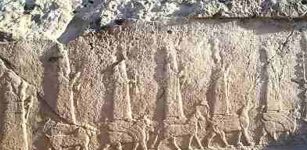 Ten Inscriptions Related To Sargon Unearthed At Ancient Assyrian Site In Iraq’s Kurdistan Region
Archaeology | Jan 20, 2020
Ten Inscriptions Related To Sargon Unearthed At Ancient Assyrian Site In Iraq’s Kurdistan Region
Archaeology | Jan 20, 2020 -
 Dangerous Anomaly Inside Mysterious European Mountain Remains Unexplained – Unusual Ancient Connections – Part 1
Featured Stories | Mar 13, 2021
Dangerous Anomaly Inside Mysterious European Mountain Remains Unexplained – Unusual Ancient Connections – Part 1
Featured Stories | Mar 13, 2021 -
 Beautiful Ancient City Of Pisac In The Sacred Valley, Peru – Incredible Inca Ruins
Featured Stories | Jun 22, 2017
Beautiful Ancient City Of Pisac In The Sacred Valley, Peru – Incredible Inca Ruins
Featured Stories | Jun 22, 2017 -
 Morrígan: Shape-Shifting Phantom Queen And Her Meeting With Irish Hero Cuchulainn
Celtic Mythology | Aug 7, 2017
Morrígan: Shape-Shifting Phantom Queen And Her Meeting With Irish Hero Cuchulainn
Celtic Mythology | Aug 7, 2017 -
 City Of Ephesus And Celsus Library With More Than 12,000 Scrolls
Featured Stories | Sep 17, 2015
City Of Ephesus And Celsus Library With More Than 12,000 Scrolls
Featured Stories | Sep 17, 2015 -
 Was The Legendary Tree Of Life Located In The Grove Of Eridu?
Featured Stories | May 19, 2016
Was The Legendary Tree Of Life Located In The Grove Of Eridu?
Featured Stories | May 19, 2016 -
 Unexplained Phenomenon In East Anglia – Time Portal And Strange Glimpses From The Past – Part 1
Featured Stories | May 31, 2018
Unexplained Phenomenon In East Anglia – Time Portal And Strange Glimpses From The Past – Part 1
Featured Stories | May 31, 2018 -
 Mysterious Books From The Unknown And ‘Impossible’ Coincidences
Featured Stories | Dec 30, 2020
Mysterious Books From The Unknown And ‘Impossible’ Coincidences
Featured Stories | Dec 30, 2020 -
 Amazing Ancient Chumash Cave Paintings In California Offer Insight Into Ancient Shamanism And Supernatural Beliefs
Civilizations | Nov 5, 2018
Amazing Ancient Chumash Cave Paintings In California Offer Insight Into Ancient Shamanism And Supernatural Beliefs
Civilizations | Nov 5, 2018 -
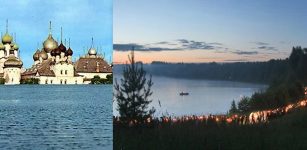 Legend Of Kitezh – Ancient Underwater City And Its Doomsday Prophecy
Featured Stories | Mar 14, 2017
Legend Of Kitezh – Ancient Underwater City And Its Doomsday Prophecy
Featured Stories | Mar 14, 2017 -
 Huge Golden Eagle Relief Made By The Aztecs Discovered At Tenochtitlan
Archaeology | Feb 3, 2021
Huge Golden Eagle Relief Made By The Aztecs Discovered At Tenochtitlan
Archaeology | Feb 3, 2021 -
 The 426-Km-Long Roman Aqueduct Provided Water For Constantinople – New Study
Archaeology | May 11, 2021
The 426-Km-Long Roman Aqueduct Provided Water For Constantinople – New Study
Archaeology | May 11, 2021 -
 Historical Enigma Of The Ancient Werewolf Ruler – What Powers Did He Possess?
Legends And Mysteries Of Europe | Jan 9, 2025
Historical Enigma Of The Ancient Werewolf Ruler – What Powers Did He Possess?
Legends And Mysteries Of Europe | Jan 9, 2025 -
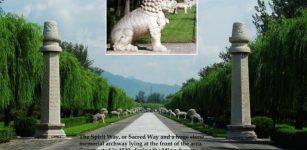 Amazing Thirteen Ming Tombs: Gigantic Stone Animals And Human Figures Were Symbols Of Royal Power
Civilizations | Oct 1, 2018
Amazing Thirteen Ming Tombs: Gigantic Stone Animals And Human Figures Were Symbols Of Royal Power
Civilizations | Oct 1, 2018 -
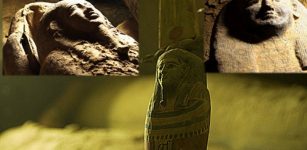 Collection Of 2,500 Years Old Sealed Coffins Unearthed In Saqqara, Egypt
Archaeology | Sep 8, 2020
Collection Of 2,500 Years Old Sealed Coffins Unearthed In Saqqara, Egypt
Archaeology | Sep 8, 2020

